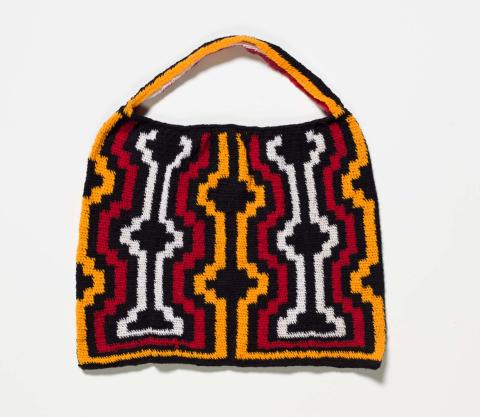Bilum and bilum-wear
'Kin' July 2022
Bilum are one of Papua New Guinea’s most significant contemporary forms of aesthetic and cultural expression. Celebrated for their striking abstract designs and bold exploration of colour, these ubiquitous bags are hand-looped by women and worn by both genders, though in slightly different styles and postures. Indeed, the language of the bilum is nuanced. The openness of the weave and the designs communicate complex cultural affiliations and responsibilities, while how they are carried signifies one’s gender and, at times, modernity.
Traditionally, Highlander women created open-looped, see-through bilums to carry items necessary to everyday life, from young children to food harvested from the garden. Worn suspended from the head, the bilum openly displayed the wearer’s labour and often signified the status of reaching womanhood. In contrast, special bilums generally decorated with rare materials were created for Highlander men to wear as part of their ceremonial bilas (ornamentation).
Today, men wear small, opaque bilums worked in commercial fibres, slung over the shoulder or around the neck to hold personal items, such as a mobile phones or betel. Younger women brought up in more urban environments adopt this fashion too, slinging brightly coloured, tightly looped bilums casually over the shoulder like a handbag. More recently, women have taken to wearing garments sporting distinctive bilum designs. Looped using the same techniques as the bilum bags, these garments, known colloquially as bilum‑wear, are worn as a proud assertion of local culture.
The patterns found on bilum and bilum-wear speak to newly found urban relationships and identities. Openwork patterns traditionally specific to particular villages and clan groups have been replaced with motifs from contemporary life, such as power poles, commercial slogans, the local SP Lager company logo or disciples from the Bible. These urban bilum are exchanged among those who speak the same language (wantok); the same geographical location (wanstret); or the same religion (wanlotu).
Connected objects

Kalibobo 2008-09
- KATA, Cathy - Designer
- ORTEGA, Wendy - Maker

Bilum-wear 2008-09
- KATA, Cathy - Designer
- SIBILI, Alice - Maker

Bilum-wear 2008-09
- KATA, Cathy - Designer
- SIBILI, Alice - Maker

Bilum (bag) 2004
- MAIMA, Gau - Creator

Bilum (bag) 2004
- MAIMA, Gau - Creator

Boroko Motors 2011
- MOREA, Sifas - Creator

Ramu sugar 2011
- THOMAS, Jully - Creator

BSP 2011
- TIVI, Leane - Creator

Bilum (diamond pattern) c.1978
- UNKNOWN - Creator

Bilum (abstract design) c.1993
- UNKNOWN - Creator

Bilum (geometric design) c.1993
- UNKNOWN - Creator

Bilum (Salvation Army pattern) c.2012
- UNKNOWN - Creator

Trukai 2011
- WALU, Aiyome - Creator

Skin pik 2013
- ERIC, Nisa - Creator

Our Beer SP 2011
- JACK, Talita - Creator